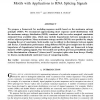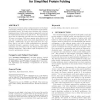121
Voted
RECOMB
2003
Springer
16 years 1 months ago
2003
Springer
We propose a framework for modeling sequence motifs based on the maximum entropy principle (MEP). We recommend approximating short sequence motif distributions with the maximum en...
117
click to vote
RECOMB
2003
Springer
16 years 1 months ago
2003
Springer
We develop a new framework for inferring models of transcriptional regulation. The models in this approach, which we call physical models, are constructed on the basis of verifiab...
101
Voted
RECOMB
2003
Springer
16 years 1 months ago
2003
Springer
137
Voted
RECOMB
2003
Springer
16 years 1 months ago
2003
Springer
A few models have appeared in recent years that consider not only the way substitutions occur through evolutionary history at each site of a genome, but also the way the process c...
101
click to vote
RECOMB
2003
Springer
16 years 1 months ago
2003
Springer
It is shown that structural similarity between proteins can be decided well with much less information than what is used in common similarity measures. The full C representation c...
111
Voted
RECOMB
2003
Springer
16 years 1 months ago
2003
Springer
Although analysis of genome rearrangements was pioneered by Dobzhansky and Sturtevant 65 years ago, we still know very little about the rearrangement events that produced the exis...
RECOMB
2003
Springer
16 years 1 months ago
2003
Springer
We describe a novel method for detecting the domain structure of a protein from sequence information alone. The method is based on analyzing multiple sequence alignments that are ...
RECOMB
2003
Springer
16 years 1 months ago
2003
Springer
In this paper, we describe a method for statistical reconstruction of haplotypes from a set of aligned SNP fragments. We consider the case of a pair of homologous human chromosome...
RECOMB
2003
Springer
16 years 1 months ago
2003
Springer
113
click to vote
RECOMB
2003
Springer
16 years 1 months ago
2003
Springer
Recent research has demonstrated quite convincingly that accurate cancer diagnosis can be achieved by constructing classifiers that are designed to compare the gene expression pro...


